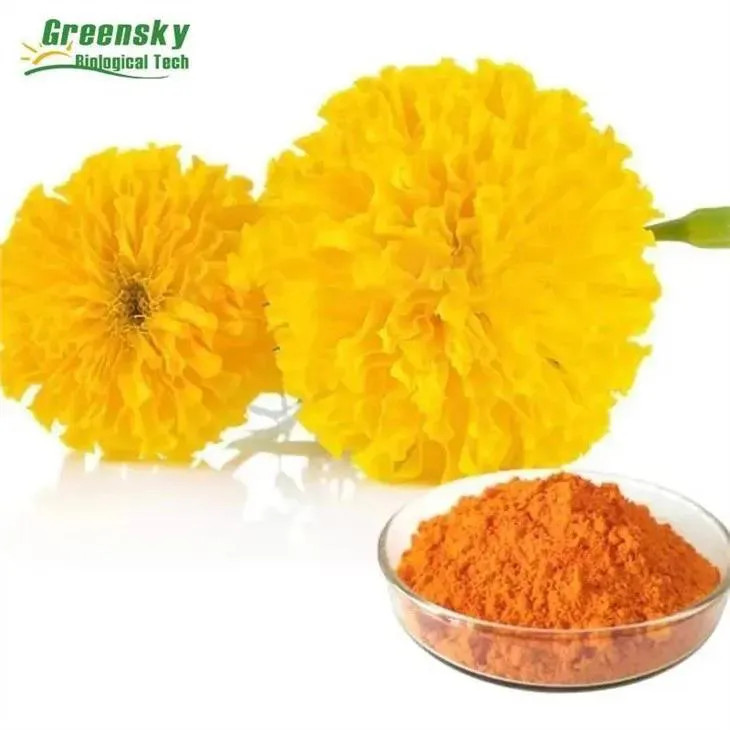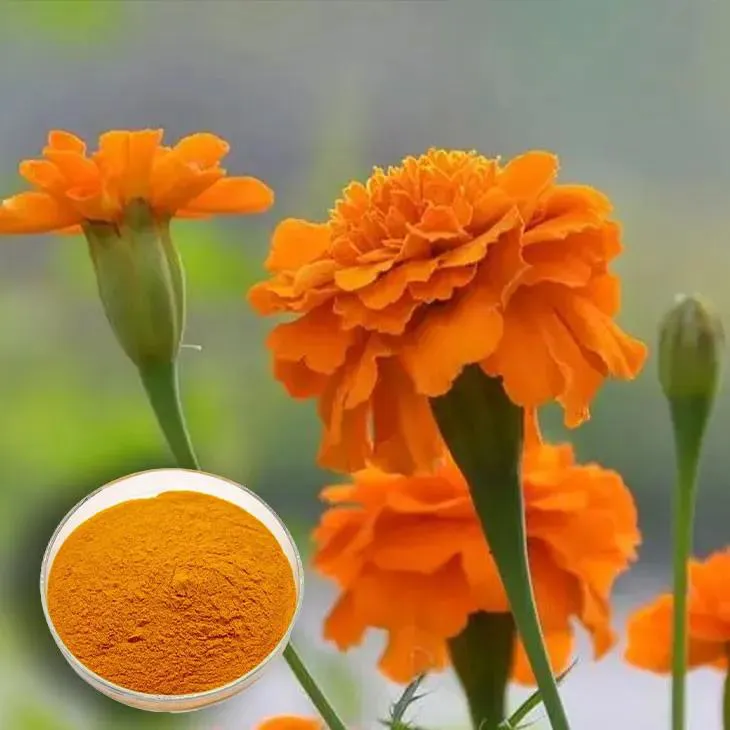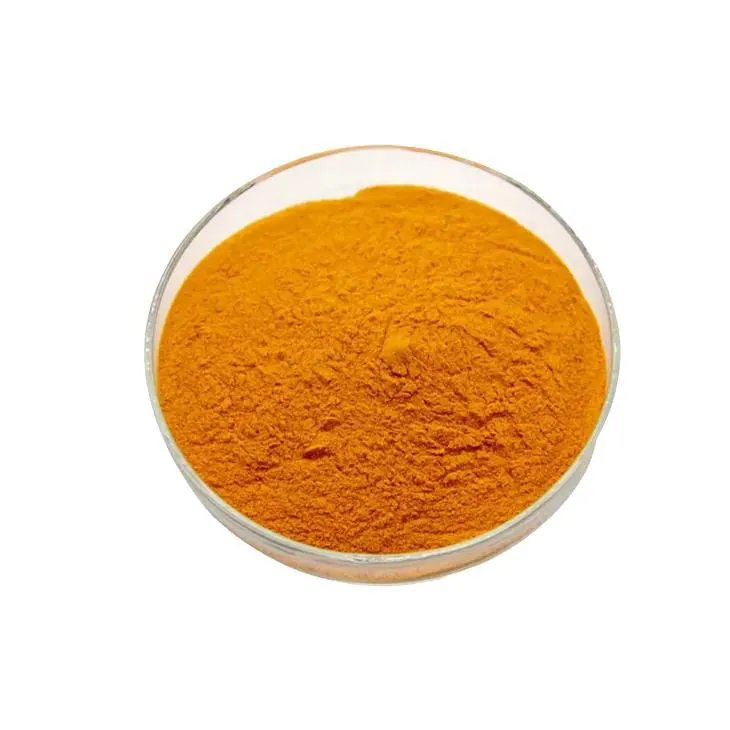- 0086-571-85302990
- sales@greenskybio.com
Marigold Extract: Uses, Advantages and Manufacturing Processes
2024-11-14

1. Introduction
Marigold Extract has been gaining increasing attention in various industries due to its unique properties. It is a natural product derived from the marigold plant, which is known for its vibrant color and potential health benefits. This article will explore the uses, advantages, and manufacturing processes of Marigold Extract.

2. Uses of Marigold Extract
2.1 In the Textile Industry
The textile industry is one of the major sectors where marigold extract is utilized. Marigold extract is used for dyeing fabrics, providing a natural alternative to synthetic dyes. The color obtained from marigold extract is not only aesthetically pleasing but also offers certain advantages. For instance, when properly treated, it has better colorfastness compared to some synthetic dyes. This means that the color is less likely to fade over time, even after repeated washing or exposure to sunlight. The warm, natural look imparted by marigold extract to textiles is highly sought after in the fashion industry. Designers are increasingly interested in creating unique and sustainable products, and marigold - dyed fabrics fit well into this trend. It gives textiles a touch of nature, making them stand out in a market flooded with mass - produced items.
2.2 In the Cosmetic Industry
Marigold extract also has a significant role in the cosmetic industry. It is often used in skincare products due to its potential antioxidant and anti - inflammatory properties. The extract can help protect the skin from damage caused by free radicals, which are known to contribute to premature aging. Additionally, it may soothe irritated skin and reduce redness. In makeup products, marigold extract can be used for its coloring properties, providing a natural and healthy - looking tint. For example, it can be found in some lip balms and blushes, giving a subtle, natural glow to the skin.
2.3 In the Food Industry
In the food industry, marigold extract is used as a natural food coloring agent. It can add a yellow - orange hue to various food products, such as baked goods, dairy products, and confectionery. The use of marigold extract as a food coloring is appealing because it is a natural alternative to artificial colorants, which may have potential health risks. Moreover, marigold extract may also contain certain nutrients that can potentially contribute to the nutritional value of the food product, although in relatively small amounts.
2.4 In the Pharmaceutical Industry
The pharmaceutical industry is exploring the potential of marigold extract for its medicinal properties. Some studies suggest that marigold extract may have antibacterial, antifungal, and antiviral activities. It could potentially be used in the development of new drugs or as an ingredient in traditional medicine. For example, it may be used in the treatment of certain skin infections or eye diseases. However, more research is needed to fully understand and harness its pharmaceutical potential.

3. Advantages of Marigold Extract
3.1 Cost - effectiveness in Production
One of the notable advantages of marigold extract is its cost - effectiveness in production. The marigold plant is relatively easy to grow in many regions around the world. It can adapt to different soil and climatic conditions, which reduces the cost associated with its cultivation. The extraction process can also be optimized to yield a large quantity of extract with relatively low costs. This is particularly important for industries that are looking to reduce production costs without sacrificing quality. By using marigold extract, companies can save on raw material costs compared to using more expensive synthetic alternatives.
3.2 Natural and Sustainable
Marigold extract is a natural product, which makes it an attractive option in today's market where consumers are increasingly interested in natural and sustainable products. It is derived from plants, which are a renewable resource. The use of marigold extract in various industries can contribute to reducing the reliance on synthetic chemicals, which may have a negative impact on the environment. For example, in the textile industry, the use of natural dyes like marigold extract can reduce the amount of chemical waste generated during the dyeing process.
3.3 Health - related Benefits
As mentioned earlier, marigold extract has potential health - related benefits. In the cosmetic industry, its antioxidant and anti - inflammatory properties can be beneficial for skin health. In the food industry, the potential presence of nutrients in the extract can add a small nutritional value to food products. And in the pharmaceutical industry, its possible antibacterial, antifungal, and antiviral activities show promise for future medical applications. These health - related benefits make marigold extract not only a useful ingredient in various products but also a potentially valuable component in promoting overall well - being.

4. Manufacturing Processes of Marigold Extract
4.1 Selection of Marigold Plants
The manufacturing process of marigold extract begins with the careful selection of healthy marigold plants. The quality of the plants is crucial as it directly affects the quality of the extract. High - quality plants are more likely to produce a rich and effective extract. Growers need to choose plants that are free from diseases and pests, and have optimal growth conditions. This may involve selecting the right variety of marigold, depending on the intended use of the extract. For example, some varieties may be more suitable for dyeing purposes, while others may have better properties for cosmetic or pharmaceutical applications.
4.2 Cultivation and Harvesting
Once the appropriate marigold plants are selected, they are cultivated. Marigolds are typically grown in well - drained soil with sufficient sunlight. Adequate watering and fertilization are also necessary to ensure healthy growth. When the plants reach maturity, the flowers are harvested. The timing of the harvest is important as it can influence the quality and quantity of the extract. For example, harvesting too early may result in a lower yield of extract, while harvesting too late may lead to a decrease in the quality of the extract due to over - ripening.
4.3 Traditional Extraction Methods
- One of the traditional extraction methods is maceration. In this method, the marigold flowers are soaked in a solvent for a period of time. The solvent can be water, ethanol, or a mixture of both. During the maceration process, the active compounds in the flowers are gradually dissolved into the solvent. This process can take several hours to days, depending on the type of solvent, the ratio of flowers to solvent, and the desired concentration of the extract.
- Another traditional method is percolation. In percolation, the solvent is slowly passed through a bed of marigold flowers. This method can be more efficient than maceration in some cases as it allows for better extraction of the active compounds. However, it also requires more complex equipment and careful control of the flow rate of the solvent.
4.4 Newer Extraction Methods
- Microwave - assisted extraction is one of the newer methods that have emerged. This method uses microwave energy to accelerate the extraction process. The microwaves heat the marigold flowers and the solvent, which increases the mass transfer rate of the active compounds from the flowers to the solvent. This can significantly reduce the extraction time, sometimes from days to just a few minutes. Moreover, it can increase the efficiency of the process while maintaining the quality of the extract.
- Supercritical fluid extraction is another advanced method. It uses supercritical fluids, such as supercritical carbon dioxide, as the solvent. Supercritical fluids have unique properties that make them excellent solvents for extracting natural products. They can penetrate the plant material more effectively and selectively extract the desired compounds. This method is often considered more "green" as the supercritical carbon dioxide can be easily removed and recycled, leaving no solvent residue in the extract.

5. Conclusion
Marigold extract has a wide range of uses in different industries, including textiles, cosmetics, food, and pharmaceuticals. Its advantages, such as cost - effectiveness, natural and sustainable nature, and potential health benefits, make it an appealing ingredient. The manufacturing processes, both traditional and newer methods, are constantly evolving to improve the quality and efficiency of extract production. As research continues, it is likely that the applications and understanding of marigold extract will further expand, opening up new opportunities in various fields.
FAQ:
What are the main uses of marigold extract in the textile industry?
Marigold extract is used for dyeing fabrics in the textile industry. It can provide a warm, natural look to textiles, and when properly treated, its colorfastness is better than some synthetic dyes, which is highly desirable for creating unique and sustainable fashion products.
Why is marigold extract cost - effective in production?
The marigold plant is relatively easy to grow in many regions. Also, the extraction process can be optimized to obtain a large quantity of extract at relatively low costs. This makes it an appealing choice for industries aiming to cut production costs without compromising on quality.
What are the steps in the traditional manufacturing process of marigold extract?
The traditional manufacturing process of marigold extract begins with the selection of healthy marigold plants, which are then cultivated. Next, the flowers are picked. After that, the traditional extraction method of maceration is used, in which the flowers are soaked in a solvent for a period of time.
How does microwave - assisted extraction improve the manufacturing process of marigold extract?
Microwave - assisted extraction can significantly reduce the extraction time and increase the efficiency of the process while maintaining the quality of the marigold extract.
Are there any other advantages of marigold extract besides cost - effectiveness?
Yes, in addition to being cost - effective, marigold extract can provide a beautiful natural color to products. It is also a natural alternative, which can be more appealing for those interested in sustainable and natural products.
Related literature
- The Properties and Applications of Marigold Extract in Dyeing"
- "Optimizing the Production of Marigold Extract: A Review"
- "Marigold Extract: New Insights into its Manufacturing and Utilization"
- ▶ Hesperidin
- ▶ citrus bioflavonoids
- ▶ plant extract
- ▶ lycopene
- ▶ Diosmin
- ▶ Grape seed extract
- ▶ Sea buckthorn Juice Powder
- ▶ Beetroot powder
- ▶ Hops Extract
- ▶ Artichoke Extract
- ▶ Reishi mushroom extract
- ▶ Astaxanthin
- ▶ Green Tea Extract
- ▶ Curcumin Extract
- ▶ Horse Chestnut Extract
- ▶ Other Problems
- ▶ Boswellia Serrata Extract
- ▶ Resveratrol Extract
- ▶ Marigold Extract
- ▶ Grape Leaf Extract
- ▶ blog3
-
High purity olive leaf extract
2024-11-14
-
Lavender oil extraction method
2024-11-14
-
100% organic virgin sea buckthorn fruit oil
2024-11-14
-
Lotus leaf extract powder factory in China
2024-11-14
-
China aged garlic extract supplier
2024-11-14
-
Deer antler extract powder manufacturer
2024-11-14
-
Saw palmetto extract vs whole herb
2024-11-14
-
Feverfew Extract
2024-11-14
-
Quercetin
2024-11-14
-
Plantain extract
2024-11-14
-
Polygonum Cuspidatum Extract
2024-11-14
-
Fenugreek Extract Powder
2024-11-14
-
Black Rice Extract
2024-11-14
-
Troxerutin
2024-11-14
-
Aminolevulinic acid
2024-11-14
-
Green coffee bean Extract
2024-11-14
-
Golden Seal Extract
2024-11-14





















